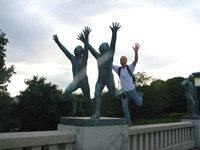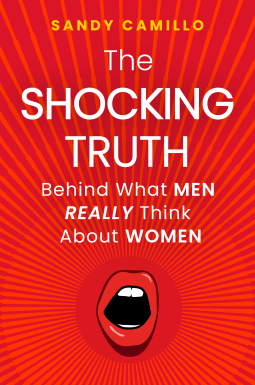A couple of years ago, I received this email that asks me a question I still get asked all the time:
Greetings Mr. Tapon,
We share the same dream of traveling the world. This is exactly what I want to do. My question is: how do you afford it? Truly, you must be wealthy to be able to do this. Any advice on how I may follow in suit?
-Jonathan, 22
Although I answered Jonathan's question on my forum, people still ask me this often. Therefore, I'm putting the answer on my main webpage so that it's easier to find. This article has two parts: (1) Tips on how you can afford to travel the world even with a modest income and (2) applying those tips in Norway, one of the most expensive countries in the world. Along the way, you can mouse-over some photos from my Norway trip with Maiu in 2008.
How Can You Afford to Travel the World?
Dear Jonathan: I assume you're talking about my dream of traveling the world.
Although you need money to travel the world, you need much less than most people think, especially if you learn how to travel frugally. Many tourists I see when I travel the world are in their 20s: hardly rich people. If they can afford to travel far and wide, so can you.
It's easy to conclude that there is only one factor in being able to travel: how much money you have. In fact, there are two factors in the travel equation:
How much you can travel = Your savings - Your travel cost
Let's talk about those two factors.
Your Savings
Savings is made up of two components as well:
Savings = Your Income - Your Expenses
Unless you live in a low-income nation, it's easy to make a lot of money. In America, for instance, you can be a waiter and make over $40,000/year.
"But that's nothing!" some cry.
That depends on what you do on the other side of the equation: expenses. We often think we MUST live in a posh home, eat out often, and wear fashionable clothes.
Having walked crossed America four times, sleeping under a tarp the whole time, I can promise you that you need little to be happy. We're all different, but if we learn to reduce our requirements and develop our budgeting skills, then we'll end up with a fortune in the bank.
For example, let's say you make $40,000/year. What if you live with 2-3 roommates/family members in a somewhat sketchy part of town, eat at home, bring your own lunch to work, buy used clothing (and not often), and avoid most discretionary expenses? Then you will save a couple of thousand bucks, even if you live in an expensive city like San Francisco, New York, or Oslo (capital of Norway).
Now imagine you make $60,000/year. Imagine still living like you're only making $40,000. Instead of saving $2,000/year, you'll save $22,000/year! (OK, just a tad less because you'll pay higher taxes, but you get the idea.)
Unfortunately, most people move up their expenses as soon as their income moves up (and often beforehand, too!). That's why some of my Harvard Business School classmates are struggling to make ends meet even with their million-dollar incomes.
I've always lived simply, no matter what my income was. I'm 50 years old, and I've never owned a couch, TV, or chair! Amazon sent me a bed and mattress for free to evaluate, so I got my first bed at 48 years old.
All the places I rented were already furnished. One place wasn't, and I slept on a used futon on the floor and had plastic plates and utensils that I washed and reused. Yes, the place was very Zen.
I also lived in three crappy neighborhoods in San Francisco. I'm not encouraging you to live like a monk in a crime-infested neighborhood. I'm simply pointing out that it's yet another major way to save money. We tend to overestimate how much we need to be happy. And we underestimate how much we can save, even when we're making a modest income.
More importantly, I was never sad, bitter, or frustrated whenever I lived in a humble abode. I loved my life and was thrilled to be living in San Francisco, one of the world's greatest cities.
In the Seattle suburbs, I lived without a car while I worked at Microsoft. I rode my bike in the rain (even with 20 kg of groceries) and took the not-so-convenient bus when I needed to. Meanwhile, co-workers who were making half my salary were driving $50,000 cars that quickly depreciate. These are the same people who ask me how I can afford to travel nonstop.
My inner-city neighbors never suspected that I was making a six-figure income. I spent about five years living well below my means, saving over 80% of my income, investing it wisely in stocks, and created enough savings to let me pursue my passions: traveling, public speaking, personal coaching, and writing.
So that's how to save, but to figure out how much you can travel, you also need to look at...
Your Travel Costs
You can guess where I'm going on this one too. Let's examine what makes up travel costs.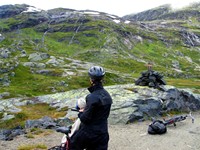
Travel Costs = Lodging + Food + Transportation + Discretionary
Lodging: Stay in the cheapest place you can tolerate. Although staying at the Ritz is fabulous, most of us travel to see stuff outside the hotel. Fancy hotels encourage you to stay IN the hotel; dodgy hotels encourage you to get OUT. I stayed in a dump in Roatan, Honduras. The shared bathroom smelled of urine, and shower water from the room above leaked onto my bed. So thanks to that crappy room, I got to know Roatan well.
Here are the progressive steps to simple, cheap lodging:
Nice Hotel => Budget Hotel => Hostel => Couchsurfing ==> Campground => Stealth Camping
Everyone has their own tolerance level. I'm just encouraging you to push your limits. Experiment! For example, after backpacking the Appalachian Trail, I didn't mind stealth camping in city parks in Eastern Europe. I've even stealth camped in Rome! I didn't do it everywhere, but wherever I did it, my lodging costs were zero. If not, hostels often cost under $20/person, which's only $600/month (cheaper than rents in expensive cities).
Food: Same concept for lodging. Of course, trying the local cuisine is part of traveling. But that doesn't mean you have to go to a 4-star restaurant. (In fact, most 4-star restaurants don't serve traditional local dishes, but fancy stuff that a local wouldn't recognize.) Street vendors sell local dishes, and they're not as sketchy as you might think. It's also fun to shop at a grocery store and see the products they have that you don't have back home. I usually buy bread, cheese, tomatoes, avocado, yogurt, granola, carrots, broccoli, and lots of fruit. As a result, my food costs are minimal, and my nutrition is high. 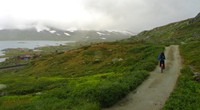
Transportation: Learn to travel simply and bring a book (or an audiobook) for when you're not enjoying the countryside (or you're waiting at a depot). Step down the luxury ladder:
Plane => Car (rental/taxi) => Train/Bus => Hitchhike
You don't just save money as you opt for the more simple transportation method, but you also get to know the locals (which, presumably, is one of the reasons you like to travel). You experience how real people are, the way they live, and you're often forced to learn some words in the local language. Aren't these reasons you love to travel?
Discretionary: Museums, performances, souvenirs, and clothes are all examples of discretionary spending. As usual, we all have our own priorities and thresholds. Just try to minimize your discretionary spending if your goal is to travel as far and as long as possible.
In short, by keeping your travel expenses down, you can make $10,000 of savings take you on nearly one year of nonstop travel! And as I wrote under the Savings section above, it's not that hard to save $10,000, even when you make a moderate salary. If you save $50,000, that's several years of ultra-budget travel.
Traveling the World with a Family
Some who have a family tell me, "Well, that's all great for someone like you, Francis, who doesn't have children, but you can't do this if you have kids!"
Although I admit that I'm no expert in raising children, most of my friends have kids, and I've often babysat. So I'm not completely clueless. I admit that families have extra expenses that chew into any potential savings. Obviously, if you have young children, you probably shouldn't live in the ghetto if you can avoid it. Nor is it practical for a family of four to stealth camp in a park in Bucharest. 
However, it's also true that most American families have enormous houses when most of the world packs a family of four in less than one or two rooms. Furthermore, "bad neighborhoods" aren't usually that bad. Most families spend way more than necessary. Even families with minimal incomes can sock away thousands of dollars a year.
Moreover, you can't say that kids don't give you enough freedom to travel since most kids have 4 months off per year. Many families also experience some degree of economies of scale that single people can only achieve if they live with roommates. Finally, most have families in their 30-50s, which is typically when people earn their highest salaries. A 25-year-old can only dream of making what someone who is 45 makes. 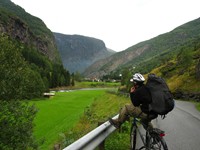
My point is that families can apply the basic ideas I've outlined here to pursue their travel dreams. They may not travel as far or as long as a childless person, but they can certainly downsize, live simply, and travel frugally. Yes, even if you have a family, you can explore the world.
Read chapter two of Hike Your Own Hike
I spend one-seventh of my book, Hike Your Own Hike: 7 Life Lessons from Backpacking Across America, detailing ways to manage your fiscal life. I encourage you to buy the book to learn to get the most out of your finances and get the most out of life itself. 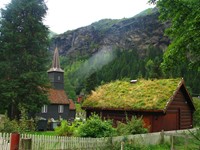
Conclusion
Traveling the world isn't as costly as you think. You can buy a round-trip ticket to most places on this planet for less than $1,000. Once you're there, you can take public transportation, stay at cheap accommodations, eat simply, and still enjoy many of the attractions while spending under $60 a day, even in the most expensive cities of the world. Frugal travelers can travel on less than half that. Budget wanderers often discover that their costs of living on the road are often lower than at home! And if you sublet your apartment or rent out your home, you can cover your home costs so you can travel for months.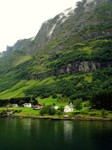
Furthermore, being frugal doesn't mean you shouldn't be generous. For instance, I pinch pennies when I travel, but I donate half of my book royalty to America's National Scenic Trails. I may hitchhike, but I always offer money to whoever picks me up (90% refuse, but thank me for the offer). I may couchsurf, but give my host gifts and help clean the kitchen. If you're tight on cash, look for non-monetary ways to give back: babysit your friend's kids for free; help clean up a beach; assist someone who is moving out; host a stranger in your house, especially if he's a smelly thru-hiker.
Finally, beware of upgrading your life too quickly. I discuss this in my book. Once you raise your standard of living, it's hard to go back.
In conclusion, live below your means, travel below your means, hike your own hike, wander and learn. 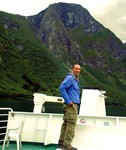
Norway: I paid too much for it, but it's worth it
Norway was special for me because it was the only major European country that I had not visited. It was also special because it drained my bank account.
Norway will test your ability to follow the advice I wrote above. Norway is a perfect case study for frugal travel. If you can travel cheaply in Norway, you can do it anywhere.
The land of the $50 dessert
Many surveys say that Japan is the most expensive country on Earth. However, I never realized that Norway is right on Japan's tail. Although I've visited Japan three times, it's been several years since I've spent any Yen. I remember it being expensive, but I wasn't mentally prepared for Norway's outrageous cost of living. It didn't help that I had just come from Central America and had gotten used to spending $3 for a 20-hour boat ride. In Norway, $3 doesn't even buy you the right to look at a taxi.
I stayed with my business school buddy, Erik Osmundsen, who is a partner at Creo. Before I arrived, he advised me to take the bus or the train from the airport to Oslo, the capital. It's "only" $60. Just for fun, I asked how much a taxi to Oslo would cost. He replied, "About $200."
"$200?! Are the taxis in Norway all private helicopters?"
[EDIT: A Norwegian commenter below said claims that my price estimates are way too high. Perhaps exchange rates have changed since I was there in 2008.]
The sticker shock continued as I surveyed the prices in Norway.
- Small personal pizza = $25
- Coke at a regular store = $5
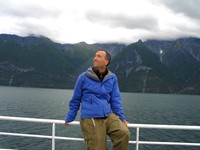
- No-frills hamburger at a diner = $20
- One Liter of Voss bottled water at a nice restaurant = $10
- Land Rover that normally costs $50,000 in the USA = $200,000
Norway's oil fields off its coast are its main source of wealth. You might believe that Norway would do what most oil-rich countries do: offer gasoline at low prices. Instead, it was near $9 per gallon.
My favorite eye-popping price was a dessert at a nice (but not world-class) restaurant = $50.
God bless Erik. He paid for it. In fact, he paid for the whole meal. Just remembering the cost brings tears to my eyes, so I'd rather not repeat it.
Why is Norway so freaking expensive????
Petroleum. Like many Scandinavian countries, the Norwegian government would tax taxes if it could. They tax cars, especially luxury cars, more than they are worth. They tax anything that moves or doesn't move. They tax the Sun, air, and snow. They are tax-coholics.
Although insane taxes raise prices, it doesn't explain why Norway is much more expensive than its tax-happy neighbors (e.g., Sweden and Finland). The only major difference between them is oil. The richness of black gold multiplies the costs.
The rough map of our journey through Norway
This crude map shows the main places we visited. We used a combination of trains, buses, boats, bikes, hitchhiking, and our feet to cover it.
View Norway on a larger map
Norway: the last European country on the list 
I have nothing against Norwegians, but I had visited all the European countries except Norway. OK, I still haven't visited Iceland, which geographers consider either half or all of the island nation to be on the European continent. So technically, I have one more European country to go to.
Overnight train from Oslo to Bergen
Maiu and I planned to meet at the Oslo airport. I would arrive at night, and she would come the next morning. I thought about taking the one-hour train ride to Oslo to spend a night at Erik's place and then returning the next morning to pick up Maiu. Price for that plan: $120 for that round-trip train ticket.
Hence, I executed Plan B: camp at the airport.
We had only 10 days to explore Norway, so we focused on the southwest region. However, for our first night, we stayed at Erik's place. He and his beautiful and friendly wife were superb hosts. The next day we went to the lovely seaside city of Bergen. 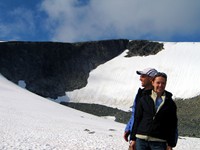
Although the overnight train ride was murderously expensive, hitchhiking is often not worth it when you don't have much time in a place because it's too slow. (Yes, sometimes hitchhiking is faster than taking public transport, but usually, that's not the case.) Besides, overnight trains are great for the efficient budget traveler: you avoid spending money on lodging and maximizing your time.
Bergen is a quaint city nestled around small mountains. It's worth seeing, especially if you can survive on the $7 loaf of bread.
The $80 bike rental on the Norwegian movie set of The Empire Strikes Back
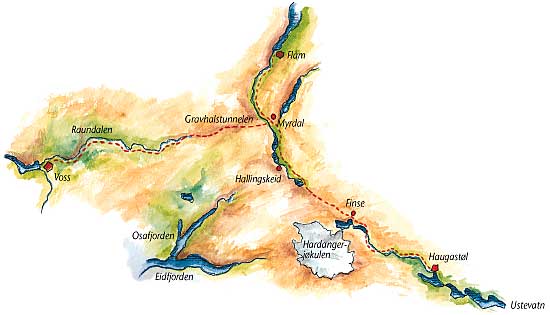
Maiu suggested we bike the Rallarvegen Norway's classic mountain route: traveling 57 km from Finse north to Flåm. Finse is high in the mountains, and Flåm is in a valley far below; between them is a wide dirt path through breathtaking alpine scenery.
The train dropped us off in Finse, a mountain pass with just a few buildings, one being a bike rental store. They offer an attractive journey at an unattractive price: bike from Finse down to Flåm and leave your bike there. The 24-hour bike rental costs just $80. I felt like telling the guy, "Dude, I can buy a bike at Walmart for $80!"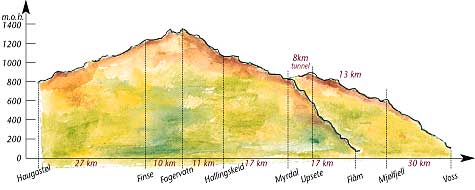
Then I realized that there aren't any Walmarts in this country, and if there were, they would probably charge $800 for the same stupid bike.
To be fair: this wasn't just a simple one-day bike rental. They lend you a helmet, and they're driving those bikes from Flåm back up to Finse, saving you the massive climb. Still, these bikes weren't motorbikes or even cool electric bikes. These were just average mountain bikes. Hell, in America, you can rent a Hummer for $80. I swallowed my horror and gave him $160 for two bikes. 
Ultra-budget travelers with a bit more time could save money by hiking the trail instead of biking it. However, you won't save $160. Covering the same trail will take most people 2-3 days, so you'll spend perhaps an extra $50 for the extra days of Norwegian food. Remember the $5 loaf of bread, right?
The dirt path is well-graded and wide enough for two bikers to ride side-by-side. Although we started in the early afternoon, we planned to push it and make the 50-km journey in one day to camp in the lower, warmer town of Flåm. Nature would force us to change these plans.
The scenery is out of this world. No wonder George Lucas picked the area around Finse to film the opening scene of The Empire Strikes Back. Star Wars fans will remember the frozen alien world as Hoth.
Frozen on Hoth 
Although it was the end of August, it was still a bit chilly. A cold thunderstorm struck in the afternoon. Our bodies (and especially our hands) were quite cold. We biked harder to generate more heat, but it was hard to warm up, even when the rain would take a break. I considered camping early to focus on warming up, but we pressed on until we found salvation.
Before the town of Myrdal, we found a mountain hut. You're supposed to have reservations, but it was open, warm, and dry. We shed our soaked clothes and put on our dry ones. It was 4 pm, but it was silly to press on in the cold rain and find a mediocre camping spot. We were on vacation and had no fixed schedule except getting the bikes back within 24 hours. Although about 20 kids showed up later, we still slept well. Although we donated some money, a Norwegian would laugh at the amount. 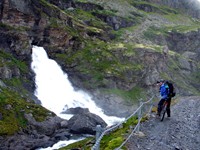
The next day, the storm had passed, and we had a blast since it was mostly downhill. We cruised on the Rallarvegen path until we glided in Flåm. Although it was certainly the most expensive bike ride I've ever had, it was worth it.
Norway's natural cathedrals: its fjords
A short bus ride (by now I was getting numb to the prices) got us to the port village of Gudvangen. It's at the base of the most majestic fjords I have ever seen. Our boat cruised through the Nærøyfjord under these vertical mountain faces that draw base jumpers and Batman-wannabes.
Watch this sick, killer video to see what I mean:
After the UNESCO World Heritage Site of Nærøyfjord, the boat docked in Sogndal. No buses were going toward Luster, so we hitchhiked. A van with three Slovak painters picked us up. Like many Eastern Europeans, they worked in Norway because they can earn 10 times more than what they get from their home country. They dropped us off near a campground, where we stealth camped. The next day we hitchhiked to the nearby national park.
Climbing to the top of Galdhøpiggen, Northern Europe's tallest mountain 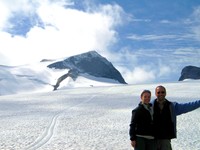
At 2,469 meters (8,100 feet), Galdhøpiggen isn't very tall, but it's the tallest mountain in Northern Europe. However, it feels much taller because of its latitude, and its climate can be just as brutal as a mountain twice its height.
Galdhøpiggen has glaciers and crevasses. Big signs are warning you not to proceed without a guide, rope, crampons, and your personal helicopter. We didn't want to think what such things might cost in Norway, so we walked past the signs, carefully traversed the glacier, and made it to the top. From the summit, you can see the stunning Jotunheimen mountain range, which is covered with glaciers.
Although I haven't researched the statistics to prove it, I firmly believe that weather is the most important factor in mountaineering. In perfect weather, almost any idiot can climb any mountain. In rough weather, an expert can die. Therefore, while many mountaineers measure you by your experience, strength, age, and other factors, I often ask just one question, "What's the weather forecast?"
On the way back down, a 58-year-old man told me that in the dozens of times he'd climbed Galdhøpiggen, he had never seen such calm and perfect weather. There was hardly a breeze on top. That's why I felt comfortable going up there with little gear or preparation. Before you go into the wilderness, make sure you know the forecast. If you don't know it, don't go or prepare for the worst. 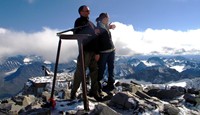
We spent the rest of the day hiking as far down the mountain as possible to get a warm camping spot among the trees.
Back to Oslo
We visited wooden churches and ate as much food as we could afford. We saw the Fram, an old ice-busting arctic boat that's now parked in a museum.
Erik was having a fancy party at his place, so we took the bus back to Oslo. We were grateful for the shower when we got to Erik's place. Although we take "bird showers" whenever possible, it's not the same as the real thing. Fresh laundry helps too.
Lessons applied
Although I never calculated exactly how much we spent, we proved that you could travel through Norway economically.
- We never paid for a hotel, which helped dramatically. (We either stayed with Erik in Oslo or camped.)
- We never ate at a proper restaurant (except when Erik generously invited us).
- We could have been more frugal with our transportation costs by hitchhiking more and not renting the $80 bikes, but sometimes it's worth it to splurge when you're time-limited.
I hope this article has inspired you to live more simply to live life more fully. Being frugal gives you the flexibility to pursue your postponed dreams. Live a rich life: one that is rich in experiences. Recalculate your net worth so that it's not based on your vehicle or bank account but your friendships, love, positiveness, and memorable experiences.
3 ways to learn more
- To learn more about traveling the world frugally, read this thread on my WanderLearn Forum. Add to it if you have more thoughts.
- Read my short article "5 Steps to Travel the World for Years."
- Download parts of my books for free. If you like the previews, please spread the word and buy Hike Your Own Hike for a friend who needs a kick in the pants.
P.S. Please share this article with your friends throughout the digital world! Thanks!


